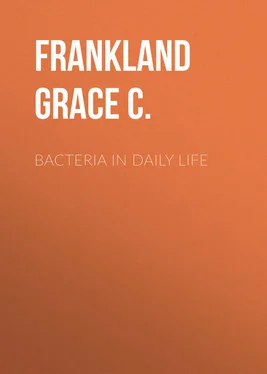Grace Frankland - Bacteria in Daily Life
Здесь есть возможность читать онлайн «Grace Frankland - Bacteria in Daily Life» — ознакомительный отрывок электронной книги совершенно бесплатно, а после прочтения отрывка купить полную версию. В некоторых случаях можно слушать аудио, скачать через торрент в формате fb2 и присутствует краткое содержание. Жанр: Медицина, foreign_antique, foreign_prose, на английском языке. Описание произведения, (предисловие) а так же отзывы посетителей доступны на портале библиотеки ЛибКат.
- Название:Bacteria in Daily Life
- Автор:
- Жанр:
- Год:неизвестен
- ISBN:нет данных
- Рейтинг книги:4 / 5. Голосов: 1
-
Избранное:Добавить в избранное
- Отзывы:
-
Ваша оценка:
- 80
- 1
- 2
- 3
- 4
- 5
Bacteria in Daily Life: краткое содержание, описание и аннотация
Предлагаем к чтению аннотацию, описание, краткое содержание или предисловие (зависит от того, что написал сам автор книги «Bacteria in Daily Life»). Если вы не нашли необходимую информацию о книге — напишите в комментариях, мы постараемся отыскать её.
Bacteria in Daily Life — читать онлайн ознакомительный отрывок
Ниже представлен текст книги, разбитый по страницам. Система сохранения места последней прочитанной страницы, позволяет с удобством читать онлайн бесплатно книгу «Bacteria in Daily Life», без необходимости каждый раз заново искать на чём Вы остановились. Поставьте закладку, и сможете в любой момент перейти на страницу, на которой закончили чтение.
Интервал:
Закладка:
Now the anaërobic bacteria are supplied along with the sewage, and the retention of their services offers practically no difficulty as long as an ample allowance of space and time is given them in which to carry on their labours. The aërobic bacteria, however, besides demanding space and time, insist upon their workshops being well ventilated, and if the supply of fresh air is in any way curtailed they stop work entirely. Hence the ventilation of the aërobic workshops becomes a matter of primary importance if the valuable services of these labourers are to be retained. To ensure a sufficient supply of air being provided, it has been found advisable to have two or more aërobic workshops or bacteria contact beds, and the sewage is passed from one on to a second, and so on, until the purification is complete. Under proper management the sewage should leave the works as an inodorous, almost pellucid liquid, incapable of putrefaction, which may be turned into rivers or other waterways without fear of rousing the wrath of local riparian authorities.
But whilst the commercial side of bacteriology, so to speak, has made such great strides, the purely scientific applications which have been made of the facts it has furnished have by no means lagged behind. Chemists, from Pasteur downwards, have made use repeatedly of special bacteria to perform delicate operations in the laboratory which other methods have either failed to accomplish or have performed in a clumsy and less expeditious manner.
There can be no doubt that, as our knowledge grows from day to day, we shall find more and more how much depends upon the work of individual bacteria, and how much importance attaches to the selection of just those varieties which are of value, and the banishment of those which are detrimental; and thus the many applications which bacteria already admit of render their easy access a matter of increasing consequence, enhancing the value of bacterial institutions such as already exist on the Continent.
But whilst the easy access of bacteria for experimental and scientific purposes is of great importance to the investigator, their indiscriminate distribution would equally be a source of uneasiness and danger to the community at large. Already sensational fiction has made considerable capital out of the pathogenic microbe, and with the winged aid of penny publications it does not take long for suggestions of such kinds to spread in society and assume practical shape, and whilst the administration of bacterial poisons offers comparatively but little difficulty, their identification would be a far greater problem for experts than that presented by particular chemical poisons. To cope with this danger to the public, specimens of disease-germs from these bacterial depôts may not be supplied to applicants unless the latter can prove to the satisfaction of the director that they are connected with responsible public institutions.
In recent times, indeed, one of the most remarkable practical uses to which bacteria have been put is that of poisoning-agents on a large scale, or in other words vermin exterminators; if this new rôle for bacteria becomes extended, as no doubt it will, the law for the sale of noxious drugs and preparations will also doubtless be amended to cover the distribution of bacterial-poisons.
It was in the year 1889 that Professor Loeffler, while experimenting with mice in his laboratory at Greifswald, discovered a micro-organism which was extremely fatal to all kinds of mice. The happy idea occurred to the Professor that this lethal little microbe, which he christened Bacillus typhi murium , might be turned to excellent account in combating plagues of field mice in grain-fields, where the devastation committed by these voracious rodents had become in parts of Greece and Russia a serious source of loss to agriculturists. Experiments were accordingly made on a small scale to test the efficiency of this bacterial poisoner in destroying field mice, and so successful were the results that Loeffler confidently announced the possibility of keeping down these pests by distributing food material infected with these bacteria over fields which were invaded by them. The Greek Government took up the question, and Loeffler's method was applied with brilliant results; the disease was disseminated with extraordinary rapidity and severity, and the mice were readily destroyed.
It is highly satisfactory to find that the character of this mouse-bacillus has stood the test of time, for after a period of more than ten years most encouraging reports concerning its efficiency still continue to be received. In one of the latest of these, drawn up by the Director of the Experimental Agricultural Institute in Vienna, we read that in no less than seventy per cent. of the cases in which it was employed it was completely successful in its work of extermination, and it is interesting to note that in a considerable number of these instances it was the domestic mouse against which its energies were directed. The rat has, however, until recently escaped the hand of the bacterial executioner, but his knell has also now been sounded in the announcement that a rat-bacillus has been discovered.
Considering the undesirable notoriety which these rodents have of late obtained in connection with their undoubted culpability in the dissemination of plague, this discovery, if correct, should be warmly welcomed. That there is plenty of work awaiting such a micro-organism may be gathered from the fact that during the outbreak of plague in Sydney the crusade against rats which followed led to the slaughter in one year of over 100,000.
The discoverer of this useful member of the microbial community is Tssatschenko, of the University of St. Petersburg, and in his memoir he states that, whilst highly virulent as regards rats, it is quite harmless to domestic animals of various kinds. Thus cats, dogs, fowls, and pigeons when fed with food infected with the bacillus suffered no ill effects whatever, whilst its administration in large quantities to farm stock, such as horses, oxen, pigs, sheep, geese, and ducks, was also without result; hence its distribution, according to its discoverer, offers no danger to other animals.
This idea of employing bacteria as executioners was not original, for Pasteur had already in 1888 suggested to the Intercolonial Rabbit Commission in Australia that chicken-cholera microbes should be employed for destroying the rabbits, which then, as now, are such a source of difficulty and pecuniary loss to the country. No active measures appear to have been taken, however, to carry out this suggestion, one of the principal objections raised being the undesirability of introducing a disease which was at that time believed to be a stranger to the colony. Recently the idea has been revived by Mr. Pound, the Government bacteriologist at Brisbane, in consequence of his discovery that chicken-cholera, far from not existing in Australia, has infested poultry yards more or less extensively for several years past, although it has only lately been accurately diagnosed as such. This chicken-cholera microbe is particularly well suited for the work in question, inasmuch as, whilst extremely fatal to rabbits, it produces, like Loeffler's bacillus, no ill effect whatever on farm-stock of various kinds, and is perfectly harmless to man, so that its handling by the uninitiated is not attended with any personal danger.
This brings us to what may be designated the human side of bacteriology, i. e. its relation to disease and its prevention. In these important departments of life the services already rendered by this infant prodigy of science can as yet be only approximately appreciated. Anthrax, tuberculosis, cholera, typhoid, plague, influenza, tetanus, erysipelas, are only a few of the diseases the active agents of which bacteriology has revealed to us. Bacteriology has, however, not been content to merely identify particular micro-organisms with particular diseases, it has striven to devise means by which such diseases may be mastered, and one of the most glorious achievements of the past sixty years is the progress which has been made in the domain of preventive medicine.
Читать дальшеИнтервал:
Закладка:
Похожие книги на «Bacteria in Daily Life»
Представляем Вашему вниманию похожие книги на «Bacteria in Daily Life» списком для выбора. Мы отобрали схожую по названию и смыслу литературу в надежде предоставить читателям больше вариантов отыскать новые, интересные, ещё непрочитанные произведения.
Обсуждение, отзывы о книге «Bacteria in Daily Life» и просто собственные мнения читателей. Оставьте ваши комментарии, напишите, что Вы думаете о произведении, его смысле или главных героях. Укажите что конкретно понравилось, а что нет, и почему Вы так считаете.












